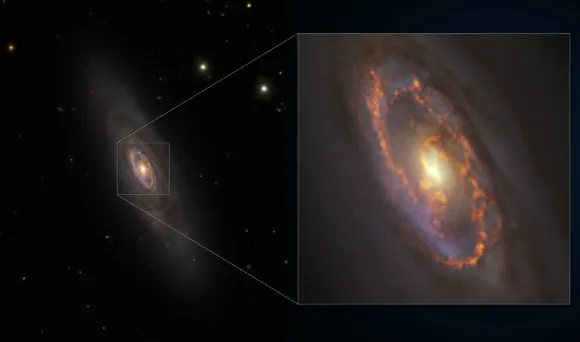
Shocking Discoveries: Astronomers Uncover New Star Formation in the Heart of NGC 1386!
2024-10-29
Author: Yu
Groundbreaking Study of NGC 1386
In a groundbreaking study, astronomers have mapped star formation in the center of NGC 1386, a stunning spiral galaxy located an astonishing 53 million light-years away in the constellation Eridanus. This remarkable research sheds light on the galaxy's inner workings and reveals the secrets of star formation in an unexpected environment.
Leadership and Innovations
Leading the study, Dr. Almudena Prieto from the Instituto de Astrofísica de Canarias, along with her team, observed NGC 1386 as part of the innovative PARSEC project. This ambitious initiative focuses on understanding the centers of nearby galaxies through a multiwavelength lens.
The Blue Ring and Stellar Clusters
"The blue ring encircling the center of this galaxy is brimming with stellar clusters hosting an abundance of young stars," the researchers remarked. This vibrant ring, rich in recent star formations, highlights a striking phenomenon in astrophysics: the remarkable ability of galaxies traditionally considered ancient to produce new star clusters.
Synchronized Star Formation
Utilizing data from the European Southern Observatory’s Very Large Telescope (VLT) and the renowned NASA/ESA Hubble Space Telescope, the research team made a remarkable discovery. All observed star clusters formed around 4 million years ago, showcasing an incredible synchronization in their birth. “This is the first time synchronized star formation has been detected in a galaxy primarily comprising older stars,” the scientists noted.
Unveiling Hidden Elements with ALMA
Digging deeper, the researchers employed the Atacama Large Millimeter/Submillimeter Array (ALMA) to unveil even more hidden elements within NGC 1386. A stunning new image revealed a golden ring representing numerous clouds of gas, lying in wait to give rise to yet another wave of young stars. "In five million years, we expect these clouds to ignite and create a new generation of stars," they explained.
Conclusion: The Vitality of NGC 1386
Despite its age, NGC 1386 continues to reveal its vitality, proving that even older galaxies can rejuvenate and produce fresh stellar life. This remarkable study was published in September 2024 in the Monthly Notices of the Royal Astronomical Society, leaving the scientific community buzzing with excitement about the implications of their findings.
Future Discoveries Await
Astronomy has never been more thrilling! As researchers unlock the mysteries of the universe, we can't help but wonder: What other secrets lie hidden in the depths of space? Stay tuned for more mind-blowing discoveries from the cosmos!



 Brasil (PT)
Brasil (PT)
 Canada (EN)
Canada (EN)
 Chile (ES)
Chile (ES)
 España (ES)
España (ES)
 France (FR)
France (FR)
 Hong Kong (EN)
Hong Kong (EN)
 Italia (IT)
Italia (IT)
 日本 (JA)
日本 (JA)
 Magyarország (HU)
Magyarország (HU)
 Norge (NO)
Norge (NO)
 Polska (PL)
Polska (PL)
 Schweiz (DE)
Schweiz (DE)
 Singapore (EN)
Singapore (EN)
 Sverige (SV)
Sverige (SV)
 Suomi (FI)
Suomi (FI)
 Türkiye (TR)
Türkiye (TR)